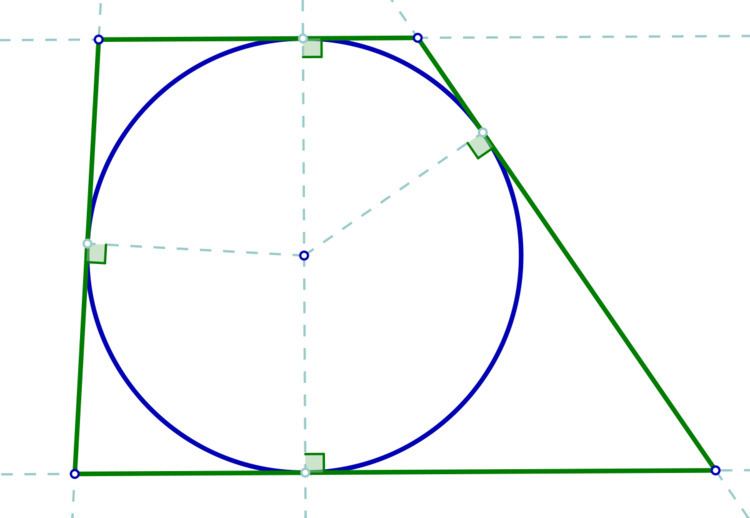 | ||
In Euclidean geometry, a tangential trapezoid, also called a circumscribed trapezoid, is a trapezoid whose four sides are all tangent to a circle within the trapezoid: the incircle or inscribed circle. It is the special case of a tangential quadrilateral in which at least one pair of opposite sides are parallel. As for other trapezoids, the parallel sides are called the bases and the other two sides the legs. The legs can be equal (see isosceles tangential trapezoid below), but they don't have to be.
Contents
Special cases
Examples of tangential trapezoids are rhombi and squares.
Characterization
A convex quadrilateral is tangential if and only if opposite sides satisfy Pitot's theorem:
In turn, a tangential quadrilateral is a trapezoid if and only if either of the following two properties hold (in which case they both do):
Area
The formula for the area of a trapezoid can be simplified using Pitot's theorem to get a formula for the area of a tangential trapezoid. If the bases have lengths a and b, and any one of the other two sides has length c, then the area K is given by the formula
The area can be expressed in terms of the tangent lengths e, f, g, h as
Inradius
Using the same notations as for the area, the radius in the incircle is
The diameter of the incircle is equal to the height of the tangential trapezoid.
The inradius can also be expressed in terms of the tangent lengths as
Moreover, if the tangent lengths e, f, g, h emanate respectively from vertices A, B, C, D and AB is parallel to DC, then
Properties of the incenter
If the incircle is tangent to the bases at P and Q, then P, I and Q are collinear, where I is the incenter.
The angles AID and BIC in a tangential trapezoid ABCD, with bases AB and DC, are right angles.
The incenter lies on the median (also called the midsegment; that is, the segment connecting the midpoints of the legs).
Other properties
The median (midsegment) of a tangential trapezoid equals one fourth of the perimeter of the trapezoid. It also equals half the sum of the bases, as in all trapezoids.
If two circles are drawn, each with a diameter coinciding with the legs of a tangential trapezoid, then these two circles are tangent to each other.
Right tangential trapezoid
A right tangential trapezoid is a tangential trapezoid where two adjacent angles are right angles. If the bases have lengths a and b, then the inradius is
Thus the diameter of the incircle is the harmonic mean of the bases.
The right tangential trapezoid has the area
and its perimeter P is
Isosceles tangential trapezoid
An isosceles tangential trapezoid is a tangential trapezoid where the legs are equal. Since an isosceles trapezoid is cyclic, an isosceles tangential trapezoid is a bicentric quadrilateral. That is, it has both an incircle and a circumcircle.
If the bases are a and b, then the inradius is given by
To derive this formula was a simple Sangaku problem from Japan. From Pitot's theorem it follows that the lengths of the legs are half the sum of the bases. Since the diameter of the incircle is the square root of the product of the bases, an isosceles tangential trapezoid gives a nice geometric interpretation of the arithmetic mean and geometric mean of the bases as the length of a leg and the diameter of the incircle respectively.
